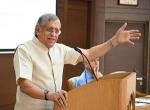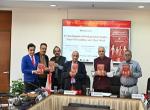A meeting of the Pakistan Study Group (PSG) was held in hybrid mode on 14 February 2024. The main items on the agenda were—the Results of the Pakistan Elections, Government formation after the Elections and the Probabilities of Coalition between Parties, The Status of PTI-backed Independent Candidates in a Post-Election Scenario, The impact of the election results on Pakistan's Economy, and The Options for the Pakistan Army. The meeting was attended by Lt Gen RK Sawhney (Retd), Mr. Tilak Devasher, Dr. Shalini Chawla, Rahul Bhonsle, Amb. Satish Chandra, Amb. D B Venkatesh Varma, Lt Gen Rakesh Sharma, Amb. Ajay Bisaria and Mr. Rana Banerjee.
Pakistan Election Results
Speculations surrounding the potential postponement of Pakistan's elections were laid to rest when the Election Commission of Pakistan (ECP) successfully concluded voting on February 8th, despite disruptions caused by the suspension of internet services nationwide, on election day. Although international observers expressed concerns about the transparency of the polling process due to delayed result announcements, voter turnout stood at 47.6 percent, slightly lower than the 52.1 percent recorded in 2018. This time, 128 million individuals were reported to be registered voters, marking an increase of 23.5 million compared to the 2018 elections. Notably, 44 percent of voters, approximately 58 million people, fell within the 18-35 age bracket, marking the highest proportion of youth participation in Pakistan's electoral history. The election featured 167 political parties vying for 265 seats in the National Assembly (NA), along with an additional 60 seats reserved for women and 10 for minorities. Initial results from the NA constituencies indicated that PTI-backed independent candidates secured over 93 seats, followed by PML-N with 75 and PPP with 54. In the Provincial Assemblies (PA), PTI-backed independents dominated in the Khyber Pakhtunkhwa (KP) Assembly. In the Punjab Assembly, PTI-backed independents secured 138 seats, while PML(N) secured 137, and PPP secured 84 seats in the Sindh Assembly, maintaining its traditional stronghold.
In addition to the mainstream political parties, other parties such as the Muttahida Qaumi Movement (MQM) secured 17 seats in the National Assembly (NA) and 28 in the Sindh Provincial Assembly (PA). Jamiat Ulema-e-Islam Pakistan (Fazl) obtained 4 seats, while Pakistan Muslim League (Quaid e Azam Group) secured 3 seats in the NA. Regional parties like the Balochistan National Party and Balochistan Awami Party secured three and one seat respectively. The Istehkam-e-Pakistan Party, which split from the PTI after the 9 May riots in Islamabad, secured two seats in the NA. Pashtun Nationalist parties such as the Pakhtunkhwa Milli Awami Party and Pakhtunkhwa National Awami Party each secured one seat. Among sectarian parties participating in the elections, the Shi’a party Majlis Wahadat-e-Muslimeen won one seat in the NA.
There were significant disparities between official and unofficial results of winning candidates. Such discrepancies led to no single party achieving a simple majority to form the government. Consequently, the formation of a coalition government became inevitable, albeit a challenging task. This process is likely to involve intense and prolonged negotiations and may result in horse-trading of independent candidates.
Post-Elections Government Formation after Coalition Probabilities
Initial discussions commenced between the Pakistan Muslim League-Nawaz (PML-N) and the Pakistan People’s Party (PPP) regarding the formation of a coalition government. Nawaz Sharif expressed interest in collaborating with political entities such as the JUI-F, MQM, PML-Q, and IPP to establish an alliance resembling the Pakistan Democratic Movement (PDM). However, early reports suggested that PPP encountered difficulties with PML-N in determining crucial constitutional and ministerial positions. Disagreements arose over appointments for roles such as Foreign Minister, Interior Minister, Finance Minister, and Chief Minister of Punjab. Despite this, PPP leadership publicly stated a preference for opposition in the National Assembly (NA) alongside PTI over aligning with PML-N, citing the latter's perceived lack of electoral mandate. Nevertheless, these statements were likely strategic moves by PPP to pressure PML-N into meeting their demands. PPP has been striving to solidify its presence in Punjab, Pakistan's most populous province, and forming a coalition with PML-N would further this effort over the next five years.
On the other hand, the PTI initially indicated its intention to sit in the opposition in the NA due to reduced chances of forming a government caused by the absence of reserved seats. Consequently, on February 13th, PTI announced that their independent candidates would join Majlis-e-Wahdatul Muslimeen (MWM) to form government at the federal and provincial levels, while negotiations with Jamaat-e-Islami (JI) were underway for the KP provincial government. However, JI declined to participate in any coalition with PTI, citing that they were approached solely for a coalition in the Provincial Assembly, not the National Assembly.
In the meantime, some independent candidates aligned themselves with mainstream political parties. Notably, PTI-backed independent candidates like Wasim Qadir, who defeated PML-N's prominent figure Sheikh Rohail Asghar in Lahore's National Assembly-121 constituency, joined PML-N following a meeting with Maryam Nawaz, daughter of party leader Nawaz Sharif.
Considering the fluid political landscape in Pakistan, marked by legal challenges, coalition talks, and potential nationwide protests, it is anticipated that PTI, despite securing the most seats at the center and in KP, will encounter hurdles in forming a government. Conversely, PML-N, alongside allied parties, is likely to establish a coalition government resembling the previous Pakistan Democratic Movement (PDM) pattern, as envisioned by the Pakistan Army.
PTI-backed Independent Candidates in a Post-Election Scenario
Amid the complexities faced, independent candidates supported by the PTI in the National and KP assemblies were exploring options to participate in the forthcoming government formation. However, these independent candidates, prior to contesting in the elections, failed to meet various election protocols stipulated by the ECP, leading to legal challenges for them. Consequently, in order to secure its allocated seats for women and minorities, PTI was keen join the MWM in the national, KP, and Punjab legislatures.
However, it needs to be understood that if PTI-backed independent candidates were to join another political party, they would be subjected to the rules and regulations of that party, potentially impeding their ability to align with PTI's policies and agendas. Given this complex scenario, numerous academics and political analysts suggest that PTI's optimal course of action would involve initiating legal proceedings against the allegedly "rigged" election outcomes in courts, which could potentially prolong the formation of the coalition government. Additionally, PTI is preparing to launch nationwide protests against the election results.
The Impact of the Election Results on Pakistan's Economy
The current post-election instability in Pakistan coincides with the country's ongoing economic crisis, characterized by diminishing foreign currency reserves. These reserves are anticipated to face further strain due to a $1 billion bond payment due in two months, alongside the expiration of Pakistan's $3 billion temporary funding program with the International Monetary Fund (IMF) on April 12. Over the past six months, Pakistan experienced some economic relief through a short-term IMF bailout package, averting a default. However, the forthcoming coalition government will bear the responsibility of negotiating an extension of the funding program with the IMF to manage annual external debt obligations ranging between $25 to $30 billion. Amidst the current political uncertainty in Pakistan regarding the formation of the next coalition government, maintaining the temporary economic stability achieved in the last six months could prove to be a daunting challenge.
It has been often discussed by policymakers and scholars that Shahbaz Sharif who is set to begin a second term as Pakistan’s Prime Minister has been the Pakistan Army’s primary choice, given his instrumental role in securing the previous IMF deal in June 2023 through direct negotiations with IMF Managing Director Kristalina Georgieva.
Any delay in government formation in Pakistan would complicate the transition to a new IMF program. Furthermore, the economy now hinges on the capability of the forthcoming coalition government to appoint a competent finance minister who can expedite discussions with the IMF and Pakistan’s partners to swiftly provide the necessary assistance to uphold the country's economic stability.
Options for the Pakistan Army
The idea of forming a coalition government in Pakistan while sidelining the Pakistan Tehreek-e-Insaf (PTI) from the political landscape didn't come as a surprise, as it was perceived as a planned strategy by the Pakistan Army, particularly given the constraints imposed on PTI during the pre-election phase. However, what has been surprising to many, including the Army in Pakistan, is the significant number of seats secured by the PTI-backed independent candidates in the elections. Nonetheless, this doesn't alter the situation much for the Army, as despite PTI winning a considerable number of seats in the central and Khyber Pakhtunkhwa (KP) regions, it appears that the coalition Pakistan Democratic Movement (PDM) alliance is poised to form the government once again.
Furthermore, the Army has effectively kept Nawaz Sharif out of contention for the position of the next Prime Minister, deeming Shehbaz Sharif more adept than his brother in managing the country's economic crisis, particularly in renegotiating IMF loans and overseeing the coalition. Given the Army's past disagreements with Nawaz Sharif during his previous tenure as PM, their expectation was for the Pakistan Muslim League (N) not to secure a majority in this election, enabling easier influence exertion by the establishment over a coalition government. Consequently, the post-election scenario suggests that the aspirations of the Pakistan Army have been realised, notwithstanding the PTI-backed independent candidates' substantial seat wins.
The Army would want to be vigilant in monitoring the role of PTI-backed independents as opposition in the National Assembly and the judiciary, where numerous election-related cases are expected to be adjudicated. Moreover, PTI is likely to spearhead nationwide protests against the alleged rigged elections, potentially diverting the government's attention from governance issues.
Ultimately, regardless of who assumes power, it has become evident that the coalition will rely on the Army for its sustenance, enabling the Army to renegotiate terms and conditions with the incoming government. Nevertheless, several political analysts believe that a faction of the Pakistan Army has kept avenues open with the former imprisoned PM Imran Khan, for potential future negotiations and compromises if the coalition government fails to meet the establishment's expectations.







Post new comment